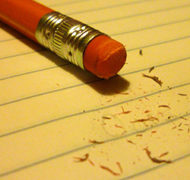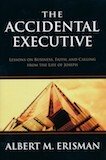Imagination and the Work of Faith
Blog / Produced by The High Calling
In third grade, I taught myself to raise one eyebrow at a time.
I had seen and heard enough by then to know this ol' world had more wretched than redeemable, and I was assertively armed and ready to express my new-found cynicism. Anything that could serve as a mirror, from the windows on the school bus to the large rectangular one over my dresser, endured my constant practice, holding down the right side while training the left muscle to rise all on its own.
My school experience had a somewhat morbid start. In the first three years, we not only mourned the Challenger's untimely demise, but had an unsettling bit of news closer to home. The unsolved murder of one of my classmates (and his family) cast a dark, ominous shadow over everything. Our small, relatively safe world shattered overnight and was replaced by a world in which fear lurked at every corner.
Third grade was also the year I learned about erasers.
We had this loopy art teacher who handed us oil paints (much to the chagrin of our mothers when standing over laundry sinks), dressed like a hippie, danced around the room, and played modern music, while we did our best to recreate Van Goghs and Picassos.
One day, however, she told us our artistic instruction for the day would begin with clipping the erasers off our sketch pencils. As we exchanged glances, she explained the best artists in the world never used them. If they made a mistake, no matter how devastating, their creative imagination could find a way to turn it into something beautiful. Without erasing.
We thought she was odd, but that wasn't really a new discovery, and so amidst a chorus of incredulous laughter, snip, snip—off came those pink circles. I remember raising my one eyebrow in her direction, skeptical humor written on my face, but it was only a cover-up. Maybe my comedy was merely to hide the way deepest beauty, the kind that emerges from the ash, touched something in me very closely related to hope.
Because, you see, life doesn't hand out erasers.
What she taught us that day had far less to do with canvas and sketch pad, and far more to do with the kind of life we had experienced over the last three years.
We would learn, through the tangible medium before us, to find a way to make glory out of catastrophe. To let imagination become a way to practice faith, both of these calling things that are not as though they were. To unlock the world for what it is, at its most elemental: teeming with possibility.
She was not only teaching us the finer points of shading and texture; she was teaching us to do the work of living creative—the courageous ability to live life without an eraser, the work of faith to believe that God is in the business of making something beautiful out of even the worst mistake. It is a lesson I have found often needs repeating, because the tendency to arch a cynical brow has remained a challenge in these years since third grade.
The coarse sound of her gravelly voice, the smell of oil paints still wet, and her flowing tie-dyed skirts waving around the art room—all wrapped in fond memory—remind me creativity cannot be confined to brush or clay.
It must be lived.
Image by Mary Kay G. Sourced via Flickr. Used with permission. Post by Kelli Woodford.
Other Posts on Creativity:





